Adenanthera pavonina L.
Family: Fabaceae
Vernacular name: Manjatti kai
Description: Deciduous tree. Leaves bipinnate, alternate or clustered. Flowers clustered, bracts linear. Pod spirally coiled after dehiscence, pointed, tapering to the base. Seeds 8-15, lenticular globose2.
Flowering and fruit: March – August |
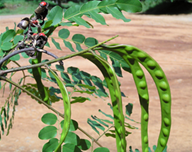
|
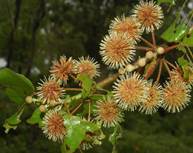
|
Adina cordifolia (Roxb.) Hook.f. ex Brandis
Family: Rubiaceae
Vernacular name: Anavu
Description: Deciduous tree. Leaves simple, orbicular to cordate, with an acuminate tip. Flower small, yellow aggregated in heads. Fruit is a capsule2.
Native: India, Sri Lanka, China
Flowering and fruit: March – June. |
Ailanthus triphysa (Dennst.) Alston
Family: Simaroubaceae
Vernacular name: Gugguldhupa
Description: A single-stemmed tree. Leaves are pinnate, large, shiny, glabrous. Flowers greenish white, polygamous in lax axillary. Fruit is samara, reddish-brown2.
Native: India, Sri Lanka, Southeast Asia, Australia
Flowering and fruit: December – April |
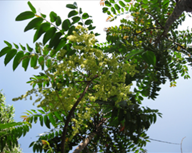
|
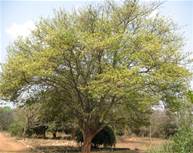
|
Albizia amara (Roxb.) Boiv.
Family: Fabaceae
Vernacular name: Tugli mara
Description: Deciduous tree. Leaves 12 cm long, petiole gland near middle or above it. Flowers subsessile. Pod greyish-brown, faintly veined2.
Native: India, Sri Lanka, Tropical Africa
Flowering and fruit: March – June |
Alstonia scholaris (L.) R. Br.
Family: Apocynaceae
Vernacular name: Haale mara
Description: Large evergreen tree. Leaves simple, bright green on the upper side. Flowers are small, greenish-white. A pair of fruits develops from each flowers. Seeds are papery2.
Native: India
Flowering and fruit: October - December |
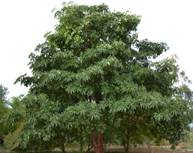
|
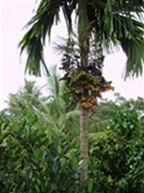
|
Areca catechu L.
Family: Arecaceae
Vernacular name: Adike mara
Description: A tall palm. Leaves long, leaflets numerous. Inflorescence much branched, glabrous. Fruit upto 5 cm long, ovoid. Seed globose to subglobose1.
Native: Tropical Asia
Flowering and fruit: Throughout the year |
Artocarpus heterophyllus Lam.
Family: Moraceae
Vernacular name: Halasu
Description: Large evergreen tree. Leaves are simple, bear two large stipules. Flowers unisexual in separate inflorescences. Entire female inflorescence together with parts of individual flowers1.
Native: India
Flowering and fruit: Throughout the year |
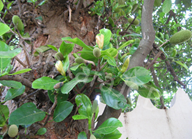
|
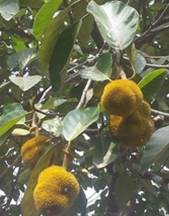
|
Artocarpus hirsutus Lam.
Family: Moraceae
Vernacular name: Hebba halasu
Description: A large evergreen tree. Leaves are simple, dark green. Female inflorescence is globose with individual flowers embedded in its axis. Female inflorescence with its constituent flowers forms a multiple fruit similar to Jack fruit but is not as big1.
Native: Tropical Asia
Flowering and fruit: December - June |
Artocarpus lacucha Roxb. ex Buch.-Ham.
Family: Moraceae
Vernacular name: Vatehuli
Description: Large tree. Leaves broadly oblong or elliptic-obovate. Inflorescence axillary, globose on short pubescent peduncles. Syncarp globose, irregularly lobed, almost smooth2.
Flowering and fruit: March – July |
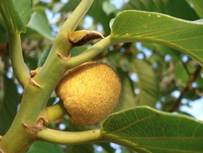
|
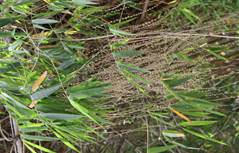
|
Bambusa arundinacea (Retz.) Willd.
Family: Poaceae
Vernacular name: Bidiru
Description: A tall woody bamboo with thorny culms, numerous and tufted. Stem-sheaths are leathery, orange-yellow. Leaves thin, linear. Inflorescence is a panicle of enormous size1.
Native: Southeast Asia |
Bombax malabaricum DC.
Vernacular name: Booraga
Family: Bombacaceae
Description: A tall native with straight trunk that is covered with hard, sharp, conical prickles. Leaves are large with 3-7 lanceolate to oval leaflets having pointed apex. Flowers are large clustered at the end of branches. Fruit ovoid in shape with five partitions. Seeds are covered with silky white hairs.
Native: India
Flowering and fruits: February – March |
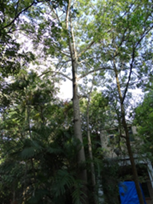 |
Broussonetia luzonica Bureau
Family: Moraceae |
Butea monosperma (Lam.)Taub.
Common name: Flame of the Forest
Family: Fabaceae
Description: A medium-sized native tree which is highly ornamental. Leavea are pinnately 3-foliate with large leaflets. Flowers are bright red or orange-red in color. Pod is broad, oblong follicle.
Native: India; Flowering: February – March |
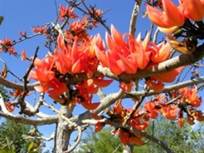
|
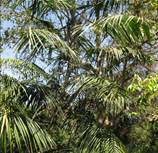 Source: 2 Source: 2
|
Calamus prasinus Lak. & Renuka
Family: Arecaceae
Vernacular name: Ontibetha
Description: A high climbing cane. Stem solitary. Leaves upto 2.5 m long, sheath flagelliferous. Inflorescence long, pendulous, primary sheath compactly sheath. Fruit globose, scales deeply channeled along the middle3.
Native: India |
Calophyllum apetalum Willd.
Family: Calophyllaceae
Vernacular name: Holehonne
Description: Tree. Leaves chartaceous, oblong-obovate. Flowers pedicellate, white, sepals 4, petals 0. Fruit drupe, elliptic2.
Native: India
Endemism: Western Ghats |
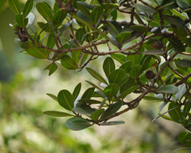
|
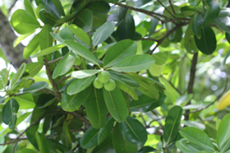
|
Calophyllum inophyllum L.
Family: Calophyllaceae
Vernacular name: Kalhonne
Description: medium to large size evergreen tree. Leaves simple, opposite decussate. Flowers are in axillary, few-flowered corymbose inflorescence. Fruit is hard, globoid2.
Native: Mozambique, Tropical Asia
Flowering and fruit: October – April |
Cananga odorata (Lam.) Hook. f. & Thoms.
Family: Annonaceae
Description: Medium –large size tree. Leaves simple, glossy. Flowers fragrant and borne in fascicles2.
Native: Indo-malaysia
Flowering and fruit: Throughout the year |

|
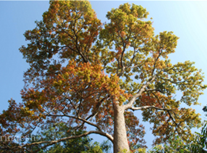
|
Canarium strictum Roxb.
Family: Burseraceae
Vernacular name: Halemaddu
Description: evergreen resinous tree. Leaves large, odd pinnate. Inflorescence is a large panicle. Flowers are polygamous and 3-merous. Fruit is a drupe2.
Native: India
Flowering and fruit: January – March, November - January |
Ceiba pentandra (L.) Gaertn.
Family: Malvaceae
Vernacular name: Bili buruga
Description: Deciduous tree. Leaves glabrous, lanceolate, cuspidate at apex. Flowers in axillary fascicles. Fruit capsules ovoid-oblong4.
Native: South and Central America
Flowering and fruit: January – March |
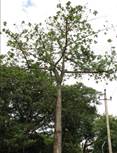
Source -2
|
 Source -2 Source -2
|
Chukrasia tabularis A. Juss.
Family: Meliaceae
Vernacular name: Kalgarike
Description: Deciduous tree. Leaves are pinnately compound, acute with unequal halves of lamina. Flowers are small, fragrant. Fruit is an ovoid capsule2.
Native: India, South-east Asia
Flowering and fruit: April |
Commiphora wightii (Arn.) Bhand.
Family: Burseraceae
Vernacular name: Konda mavu
Description: Tree. Leaflets 1-3, obovate, serrate in the upper part. Flowers fascicled. Petals brownish-red. Fruit drupe, ovoid2.
Native: Western and peninsular India |
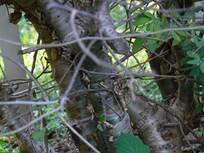
|
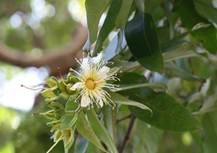
|
Duabanga grandiflora (Roxb. ex DC.) Walp.
Family: Lythraceae
Description: Tree. Leaves large. Flowers are large, attractive. Sepals are fleshy and persistent. Sepals are fleshy and persistent5.
Native: Cambodia, India, Laos
Flowering and fruit: February – April |
Elaeocarpus serratus L.
Family: Elaeocarpaceae
Vernacular name: Beejadamara
Description: Large –sized tree. Leaves simple, elliptic. Inflorescence is a raceme. Flowers white, oriented facing downwards. Fruit is a drupe, pyrenes are tuberculate2.
Native: India, Sri Lanka, Bhutan, Nepal. China, Myamnar, Java, Malaysia
Flowering and fruit: April – May |
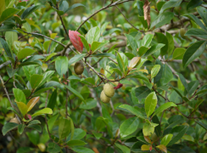
|
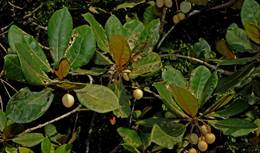 Source -2 Source -2
|
Elaeocarpus tuberculatus Roxb.
Family: Elaeocarpaceae
Vernacular name: Rudraksha
Description: Large tree with buttressed. Leaves simple, obovate, clustered at the ends of branchlets. Flowers are white with yellow tinge. Fruit is a drupe with smooth surface2.
Native: India, Malaysia
Flowering and fruit: January - May |
Entada rheedei Spreng.
Vernacular name: Hallekaayi-balli, Pallekaayi (Kannada)
Description: It is a gigantic climber with twisted angled stems. Leaf-rachis glabrous, grooved, ending in a bifid tendril, pinnae 2-3 pairs, leaflets 3-4 pairs, ovate-oblong, obtuse of emarginated at apex. Spikes upto 30 cm long, from the axils of upper leaves or from nodes on the leafless branches. Flowers pale yellow. Pod woody, 6-15 jointed, 100*10 cm, joints discoid or square. Seeds glossy brown, with vary hard testa.
Flowering: March – May; Fruit: June |
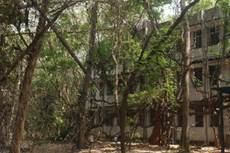
|
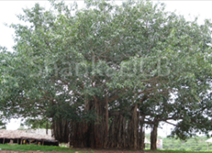 Source -2 Source -2
|
Ficus benghalensis L.
Family: Moraceae
Vernacular name: Aladamara
Description: Gaint evergreen tree. Bark is grey-brown, relatively smooth, milky latex when cut. Leaves simple, leathery and alternate. Figs are about 2 cm. diameter, rich red. Regarded as ‘Keystone’ species1,2.
Native: India
Flowering and fruit: Throughout the year |
Ficus racemosa L.
Family: Moraceae
Vernacular name: Atthimara
Description: Large tree with latex. Leaves simple, ovate, glossy-green. Galls are seen on leaf. Figs yellow-orange edible in clusters are borne on main trunk1,2.
Native: India
Flowering and fruit: Throughout the year |
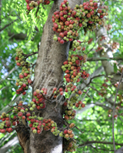
|
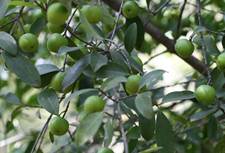
|
Garcinia indica (Thouars) Choisy
Family: Clusiaceae
Vernacular name: Murgina hulimari
Description: Large evergreen tree. Leaves are opposite, leathery, red when young and oblong lanceolate. Flowers small, axillary as well as terminal. Petals four. Fruit is globose2.
Native: India
Flowering and fruit: March - April |
Holigarna grahamii (Wight) Kurz
Family: Anacardiaceae
Description: Large-sized evergreen tree. Leaves simple, large with obovate-elliptic lamina. Flowers are polygamous, calyx toothed and accrescent. Fruit is a drupe2.
Native: India
Flowering and fruit: December – May |
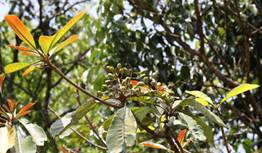 Source -1 Source -1
|
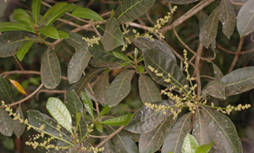
|
Holigarna arnottiana Hook. f.
Family: Anacardiaceae
Vernacular name:Sanna holegare
Description: Large tree of evergreen and semi evergreen. Leaves simple, obovate or oblanceolate. Inflorescence is a panicle withg pale golden brown tomentum. Fruit is elliposoidal drupe2.
Native: India
Flowering and fruit: January - March |
Hopea ponga (Dennst.) Mabb.
Family: Dipterocarpaceae
Description: Lofty tree. Leaves simple, oblong-lanceolate, yellow tomentum. Flowers borne on branched inflorescence. Petals are ovate-lanceolate. Wings of samara green, turning red when mature2.
Native: India, Flowering and fruit: July – November |
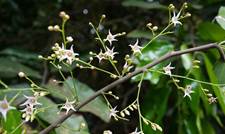
|
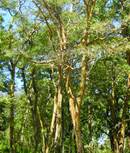
|
Lagerstroemia lanceolata Wall. ex C. B. Clarke
Family: Lythraceae
Description: Large deciduous tree. Leaves simple, elliptic, entire, opposite. Flowers in terminal panicles. Fruit capsule ellipsoid, brownish1.
Flowering and fruit: March - May |
Lophopetalum wightianum Arn.
Family: Celastraceae
Vernacular name: Banale
Description: Evergreen buttressed tree. Leaves opposite, obovate or obtuse-acuminate. Flowers 1.6 cm across. Fruit capsule oblong, coriaceous2.
Native: Indo-malayan
Flowering and fruit: November |
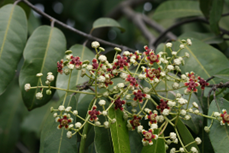
|
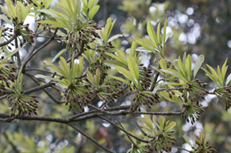
|
Madhuca longifolia (Koenig) Macbr.
Family: Sapotaceae
Vernacular name: Sanna Ippe
Description: Evergreen tree. Leaves chartaceous, oblanceolate, glabrous, apex acute. Flowers creamish-white, long pedicellate umbels. Fruit berry ellipsoid, glabrous2.
Native: India, Sri Lanka, Myanmar
Flowering and fruit: March - June |
Mallotus philippensis (Lam.) Muell.-Arg.
Family: Euphorbiaceae
Vernacular name: Kampillaka
Description: Small sized evergreen tree. Leaves simple, ovate-lanceolate. Flowers unisexual, male and female occurring on different tree in terminal elongate inflorescence. Fruit is three-lobed orange-red small capsule.
Native: Asia; Flowering and Fruit: November |
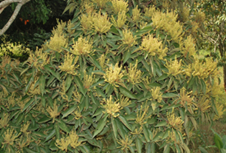
|
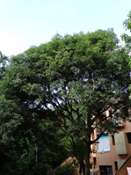
|
Mangifera indica L.
Vernacular name: Maavu
Family: Anacardiaceae
Description: Moderate sized tree, up to 8 m high. Leaves alternate or sub-opposite, simple, exstipulate, lanceolate, undulate, acute or acuminate. Inflorescence a terminal panicle. Flowers polygamous. Fruit a fleshy drupe, orange yellow, heart-shaped.
Native: India
Flowering and Fruits: February – May |
Memecylon umbellatum Burm. f.
Vernacular name: Mundi Alle
Family: Melastomataceae
Description: Tree. Leaf blade ovate-elliptic, nerves faintly visible. Calyx campanulate. Fruit berry to 5 mm in diameter1,2,6,7.
Native: India, Sri Lanka
Flowering and fruit: March – July |
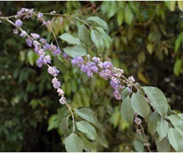
|
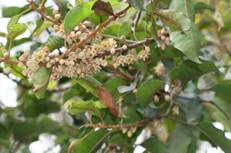
|
Mimusops elengi L.
Vernacular name: Pagadi mara
Family: Sapotaceae
Description: Evergreen tree. Leaves simple, alternate, glossy-green with wavy margins. Petals are many. Fruit is berry, green at first, turning red-yellow when ripe2.
Native: India
Flowering and fruit: May - June |
Mitragyna parvifolia (Roxb.) Korth.
Family: Rubiaceae
Vernacular name: Kadamba
Description: Deciduous tree. Leaves obtuse-acute, suborbicular-ovate. Calyx limb short. Corolla creamy, white, sparsely pilose within. Fruit capsule in globose head2.
Native: India, Sri Lanka, Bangladesh
Flowering and fruit: May – August |
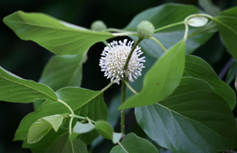
|
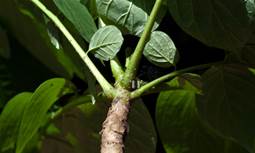 Source -1 Source -1
|
Pajanelia longifolia (Willd.) K. Schum.
Family: Bignoniaceae
Vernacular name: Mokkudu
Description: Deciduous tree. Leaves imparipinnate, compound. Glabrous, leaflets opposite, margin entire, chartaceous. Inflorescence panicle. Purplish outside and yellow within. Fruit capsule, brown1.
Native: India and Myanmar
Flowering and fruiting: January-June |
Sterculia guttata Roxb. ex DC.
Family: Malvaceae
Vernacular name: Hultioradu mara
Description: tree. Leaves simple, ovate, entire, rounded to cordate at base, palmately 3-5-nerved, softly tomentose. Follicles obovoid, rugose. Seeds on short stout funicles with spreading bristles2.
Native: Peninsular India, Sri Lanka
Flowering and fruit: January – February |
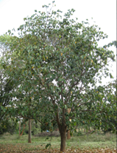 Source-2 Source-2
|
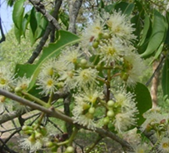
|
Syzygium cumini (L.) Skeels
Vernacular name: Neerale
Family: Myrtaceae
Description: Tall tree. Leaves simple, elliptic, lush-green and leathery with insect galls. Numerous flowers aggregate into dense cluster with long stamens. Fruit is globose to oblong, single-seeded berries1,2,6.
Native: South-east Asia;
Flowering and fruit: February - September |
Syzygium laetum (Buch.-Ham.) Gandhi
Family: Myrtaceae
Vernacular name: Dev Jambhul
Description: Small tree. Leaves chartaceous, ovate-elliptic. Cymes terminal, few flowered. Flowers large. Fruit berry elliptic-ovate, dark brown2.
Native: India
Flowering and fruit: December – February |
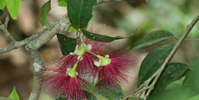 Source-2 Source-2
|
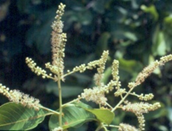
|
Terminalia arjuna (Roxb. ex DC.) Wight & Arn.
Vernacular name: Holimathi
Family: Combretaceae
Description: A large evergreen tree. Leaves are simple, oblong, crenulate and leathery in texture, petiole glandular. Flowers are small, white and are borne on catkins. Fruit is ovoid with 5-7 angles or wings1,2,6.
Native: India; Flowering and Fruit: May - February |
Terminalia crenulata Roth
Vernacular name: Kirajul mathi
Family: Combretaceae
Description: Tree. Leaves alternate or subopposite, crenulate or entire, glabrous or tomentose. Spike branched. Flowers pale yellow. Fruit 5-winged, reddish when mature2.
Native: India, Southeast Asia
Flowering and fruit: August - January |
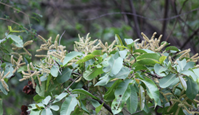 Source-2 Source-2
|
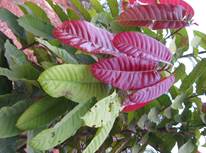
|
Vateria indica L.
Family: Dipterocapaceae
Vernacular name: Dhupadamara
Description: Tree. Leaves elliptic-oblong, coriaceous, glabrous, acuminate. Flowers white. Fruit capsule to 4.5 cm long, fleshy, obtuse.
Native: India |
Vitex altissima L.f.
Family: Lamiaceae
Vernacular name: Bharanige
Description: A large dry deciduous and semi evergreen forests. Leaves are compound with three or five leaflets. Flowers are numerous on branched inflorescence, small. Fruit are small and purplish-black when ripe1,2,6.
Native: Tropical Asia; Flowering and fruit: October - December |
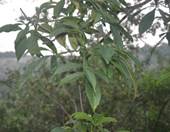
|
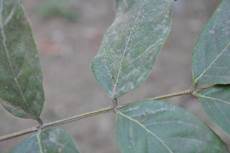
|
Xylia xylocarpa (Roxb.) Taub.
Family: Fabaceae
Vernacular name: Jambe
Description: Unarmed tree. Leaflets 3-5 pairs, elliptic-lanceolate, acuminate, with glands in between. Corolla yellowish-white. Pod brown-pubescent, axe-shaped1,2,6.
Native: Indomalesia; Flowers: March – May, Fruit: May – January |
Ziziphus rugosa Lam.
Family: Rhamnaceae
Vernacular name: Kotte hannu
Description: Shrubs. Leaves broadly elliptic or elliptic –ovate, rounded. Flowers in long-peduncled panicles. Fruit drupe globose or oblong. White when ripe2.
Native: India, Sri Lanka
Flowering and fruit: February - April |
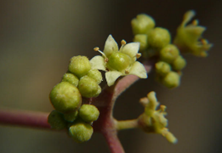
|
It is observed that in less than 25 years, the experimental plot, now termed ‘Miniforest’ on account of the limited area, is transformed into a lush green forest on a terrain that was originally a scrub vegetation of the Deccan plateau type with apparently conditions alien to most of the species that have been introduced. The miniforest, in this respect, presented an opportunity to study the adaptations capability of the Western Ghats native forest species in Deccan plateau. The species composition that emerged in the experimental plot is quite interesting. Majority of them are the Western Ghats species whereas the others, the native to scrub vegetation, both found growing in perfect harmony, in spite of the difference in rainfall (850 mm), humidity, temperature and soil conditions for the former species.
The miniforest trees exhibited normal robust growth, flowered and set fruit as they would do in their native habitat. Some of the trees, for example Mitragyna parvifolia (Roxb.) Korth., Chukrasia tabularis A. Juss., Duabanga grandiflora (Roxb. ex DC.) Walp., Garcinia indica (Thouars) Choisy, Holigarna grahamii (Wight) Kurz, Lophopetalum wightianum Arn. and Syzygium laetum (Buch.-Ham.) Gandhi have grown as well as they would do in the evergreen forests.
The area developed rich micro- and macro-fauna, from insects, frogs, snakes to birds and smaller mammals like the most elusive Slender Loris. Smaller plants such as mosses, algae, fungi, ferns, herbaceous plants and climbers have grown well adapting to the change. The entire plot is amazingly transformed into the type of a habitat that prevails in the moist forests of Western Ghats. The water table at this location was in the range of 60- 70 m depth before. At Present monitoring of water table shows the level of water is at about 3 to 3.5 m below the ground. This indicates that land cover dynamics play a decisive role in recharging the groundwater sources. Other ecological benefits have resulted from creating the miniforest in urban ecosystem are;
- Improved campus microclimate (temperature is at least 2º C lower than other parts of 178 hectares campus) and reduced SO4 and Suspended Particulate Matter in the atmosphere which was emitted by the vehicles;
- Carbon sequestration and reduction in air pollution - reduced atmospheric CO2 ;
- Reduced surface water runoff; infiltration of rain water and recharging of ground water resources;
- Eradication of invasive plant sepceies;
- Supports diverse fauna (4 families of Slender Loris, wide variety of reptiles, butterflies, etc.);
- Mitigation of temperature and urban heat islands;
- Enhanced the aesthetic value (feel of rain forest in Bangalore);
- Good experimental plot with diverse micro habitats;
- Enhanced the recreation and has become campus visitor’s favourite spot.
Reference:
- Western Ghats Ecology and Biodiversity Portal, ENVIS: http://wgbis.ces.iisc.ac.in/biodiversity
- Photographs – Source 1, Indian Biodiversity Portal, http://indiabiodiversity.org/species
- Photographs – Source 2, Flora of Karnataka, http://florakarnataka.ces.iisc.ac.in/hjcb2
- Gopalakrishna Bhat, 2011. Palms of Karnataka. [Published by K. Gopalakrishna Bhat, Madhuca, Srinivasa Nagara, Chitpady, Udupi].
- Gopalakrishna Bhat, 2003. Flora of Udupi, Indian Naturalist, Udupi.
- K. Sankara Rao, 2010. Flowering Plants of Indian Institute of Science: A Field Guide.
- S V Ramaswamy, B A Razi, Flora of Bangalore District, Published by the Director, Prasaranga, University of Mysore, Manasagangotri, Mysore – 570012, pp L+740
- Flowers of India (http://www.flowersofindia.net/)
| 











 Source: 2
Source: 2 




 Source -2
Source -2 


 Source -2
Source -2 
 Source -2
Source -2 

 Source -1
Source -1 









 Source -1
Source -1 Source-2
Source-2
 Source-2
Source-2
 Source-2
Source-2



